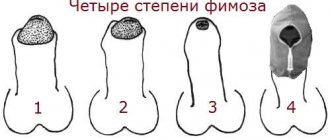Phimosis is a narrowing of the external opening of the foreskin. This is one of the most common malformations of the penis. Its prevalence ranges from 15.3% to 22.7%, of which every third are children under 7 years of age. It must be remembered that phimosis can be congenital and acquired. Congenital narrowing of the foreskin is observed in most newborns as a physiological phenomenon up to 4 years of age. During the first 4 years of life, the preputial foramen expands; physiological phimosis resolves spontaneously by the age of 4 and does not require additional correction. Physiological phimosis has all the same complications as ordinary, acquired phimosis. Don't waste your precious time - call!
Our specialists will be happy to answer all your questions
+7
What does phimosis look like?
Phimosis: causes, symptoms, treatment of phimosis in boys Why does phimosis occur?
What are the causes of phimosis? Acquired phimosis can be formed under the influence of various factors:
Inflammation of the foreskin and glans penis (balanoposthitis) can lead to swelling of the foreskin and a temporary decrease in the diameter of its external opening. Mechanical trauma can lead to the formation of scar tissue (not able to stretch) of the foreskin.
In childhood, during the period of active growth of the head and foreskin, a temporary or permanent discrepancy between the diameter of the head and the external opening of the foreskin may occur.
Insufficiency of connective tissue in the body, which has a genetic predisposition.
Synechia - adhesions between the head of the penis and the foreskin prevent the release of the head of the penis; they are a normal variant in children under 3 years of age. Very often, physiological lubricant or smegma is visible under the skin - this is a curdled mass, which is a good breeding ground for microorganisms and often causes the inflammatory processes of balanitis and balanoposthitis. It is recommended to breed synechiae.
Causes of phimosis
Medical practice has not established a list of specific causes that provoke phimosis of the glans penis. Pathological changes in the tissues of the foreskin can be caused by both heredity and other factors of a general or local nature.
- Blood diseases.
- Age-related changes in the skin, a decrease in the number of collagen fibers.
- Local inflammation.
- Phimosis is observed in diabetes mellitus and immunodeficiency states.
- Injuries received during sexual intercourse and the appearance of scars on the foreskin.
The cause of the development of the pathology is determined by a specialist during examination of the patient. Depending on the information in the anamnesis, a decision is made on treatment methods.
Nature of pathology
The foreskin is called the preputium. According to physiological standards, it reliably protects the delicate epidermis of the head from drying out, dirt, mechanical damage, friction, dangerous microorganisms and other harmful environmental factors. Circumcision without a medical reason leads to a hardening of the outer covering of the penis, an increased risk of inflammatory and infectious diseases, and a decrease in the severity of sensations during sexual intercourse.
Physiology provides a mechanism for retracting the prepuce back along the organ, while the head is released. This is required by sexual intercourse and hygiene procedures. The removal of the outer covering is limited by the frenulum, which is located on the underside of the penis and resembles a tongue frenulum in structure. This entire mechanism is natural and painless. Softening is facilitated by a secretory fat-like fluid secreted by the glands of the preputium, which is called “smegma”. It not only acts as a natural lubricant, but also contains antibacterial substances aimed at protecting against infections.
When observing symptoms of phimosis, a violation of the basic mechanism occurs: exposure of the head is either difficult or impossible at all. This phenomenon may have natural causes and is not considered a painful condition that requires urgent medical treatment. Natural phimosis is a congenital feature that is observed in newborn boys. Unlike the pathological condition, its cause is not associated with changes in the structure of the preputium. The main explanation for the condition is the immaturity of the tissues of the epidermis of the head and the outer cover, which did not have time to separate. Existing adhesions disappear on their own by desquamation of cells, which are excreted naturally during urination. The duration of the process is individual: for one child it may end by the age of three, for another during puberty.
In some cases, tissue separation does not occur and signs of phimosis are observed in a mature man. In this case, they already talk about a deviation that requires medical observation and treatment. The main reason for such cases is said to be deviations in the genetic code, causing structural abnormalities or lack of connective tissue.
Important! The parents of the young man should pay attention to this fact. If puberty has occurred and the head is not completely open, you need to visit a urologist. At the initial stage, the problem can be dealt with without surgical interventions.
Secondary or acquired phimosis should be distinguished from natural one. It can appear at any age and is a consequence of non-compliance with sanitary care recommendations, injury and microdamage. Phimosis in men is a complication with frequent relapses of inflammatory processes and infections that are advanced or difficult to treat.
The appearance of secondary phimosis in boys is rarely associated with inflammation or infectious complications. Normally, parents monitor with sufficient care the rules of hygiene and care for the baby. Sometimes excessive zeal becomes the cause of pathology. If adults tried to forcibly open the tip of a child’s penis, then mechanical ruptures of congenital adhesions occur, which have not yet had time to disappear. Invisible damage, ulcers are replaced by scars and scars. This sclerotic tissue deprives the outer cover of the organ of plasticity and extensibility. The resulting tissue changes become a pathology requiring medical supervision and treatment.
Types of phimosis
Physiological phimosis, observed in childhood, in most cases goes away on its own. In an adult man, the pathology can be not only congenital, but also acquired - it is already unlikely to get rid of the problem without the intervention of a specialist.
The mechanisms of pathology development allow us to distinguish 3 types of phimosis.
- The atrophic type is characterized by thinning of the skin of the foreskin and a decrease in tissue volume.
- Compaction of the epithelium outside the head, leading to a decrease in the ring of the foreskin, is characteristic of the hypertrophic type of the disease.
- Cicatricial phimosis forms in men due to injury to the tissues of the praeputium, loss of elasticity, which allows the head of the penis to be removed.
Remember that a specialist must classify the patient’s problem. Depending on the etiology of the disease, a decision will be made on treatment methods.
Price and cost of surgery for phimosis in children
Phimosis
| Service | Price |
| Phimosis: Circumcision of the foreskin (circumization) | 34500 rub. |
| Phimosis (circumcision) with frenuloplasty | 42500 rub. |
| Phimosis (circumcision) with meatal stenosis (urethral stenting) | 58,000 rub. |
| Phimosis (circumcision) with meatal stenosis (urethral stenting) and frenuloplasty | 72,000 rub. |
| Treatment of meatal stenosis (1st degree of complexity) | 45,000 rub. |
| Treatment of meatal stenosis (difficulty level 2) | 52,000 rub. |
| Treatment of meatal stenosis (grade 3) | 59,000 rub. |
The price list published on the website is not a public offer agreement.
The provision of services is carried out on the basis of an agreement for the provision of medical services. We ask you to check the cost of services with your attending physician in advance. Don't waste your precious time - call!
Our specialists will be happy to answer all your questions
+7
Reviews
Today I would like to leave a review about Dr. Matar’s clinic: Dear Asaada Akhmadovich, thank you very much for the excellent operation: “plasticity of the foreskin and plasticity of the frenulum,” which you performed on my son (10 years old) with a wonderful result! After a detailed and attentive consultation with you, it immediately became clear to us that surgery was necessary and conservative treatment methods would not bring results.
- Elena Cicatricial phimosis
I would also like to leave my review. I wanted it for a long time, got hooked and forgot. And then they asked me the name of the doctor whom I could contact about phimosis, and without hesitation I named Dr. Matara.
- Alexandra Fimoz
I would like to express my HUGE THANKS to Matar Asaad Akhmadovich for his sensitive, attentive attitude, kindness and of course PROFESSIONALISM. We operated on the hidden penis at the age of 10 in March 2012 with Matar Asaad Akhmadovich.
- Anna Odintsova Fimoz
Our advantages
Experienced surgeons
Individual approach
Without pain and fear
Comfortable conditions
Symptoms and stages of phimosis
A man must understand when seeing a doctor becomes necessary. The following symptoms should alert you:
- pain during erection;
- the foreskin of the penis moves with force, or does not allow the head to be exposed at all;
- severe acute pain in the head, cyanosis;
- impossibility of normal outflow of urine from the urethra - accumulation under the skin of the foreskin with subsequent leakage;
- the appearance of inflammatory foci of varying severity - suppuration, increased temperature.
There is an opinion that a man can live calmly with phimosis. In practice, this means the presence of a slight narrowing of the prepuce, which does not cause significant discomfort, which is observed at the initial stage of the disease.
Classification of the severity of phimosis in men by stages:
- I – at rest the foreskin moves freely, with an erect penis – difficulties and discomfort are observed.
- II – without an erection, withdrawal of the head occurs with difficulty; when the penis is filled with blood, exposure is impossible.
- III – even without an erection, only partial exposure is possible;
- IV – visual inspection of the head of the penis is impossible, the foreskin prevents urination, and there are signs of inflammation of the head of the penis (balanitis).
You need to understand that stage 1 phimosis treatment involves a more gentle treatment than an advanced disease with multiple complications.
Phimosis
Phimosis is the inability to expose the head of the penis. Only 4% of newborn boys have a foreskin that is so mobile that the head of the penis can be fully exposed. At the age of 6 months, the head of the penis opens in 20% of boys, and at the age of 3 years, the foreskin moves well and allows the head of the penis to be exposed in 90% of boys. Therefore, children under 3 years of age are not recommended to undergo circumcision, the indication for which is phimosis. The exception is cases of severe inflammation of the head of the penis (balanitis), as well as difficulty urinating and complications arising in connection with this, when surgery is recommended at any age.
Symptoms
The main symptom is the inability to remove the head of the penis. There may be no complaints, but with severe phimosis, complaints of urination problems appear. During urination, the child is worried and strains. Urine, entering the preputial cavity, swells it and exits through the narrowed opening in a thin stream or drops.
In cases where the inflammatory process is associated, typical complaints are pain in the area of the glans penis and foreskin, purulent discharge from the opening of the foreskin, enlarged lymph nodes, and increased temperature. With paraphimosis, acute pain occurs in the restrained head, the head increases in size and turns blue. This is an emergency situation that requires immediate attention.
In adult patients, there are complaints of decreased potency as a result of a psychological reaction to painful sensations during sexual intercourse.
Causes
Trauma to the penis, which may result in the formation of scar tissue leading to narrowing of the foreskin (so-called cicatricial phimosis); Inflammation of the foreskin of the penis (balanoposthitis), also leading to scarring and phimosis; Genetic predisposition to the formation of phimosis as a result of insufficiency of connective tissue in the body, in particular its elastic component. [edit] Classification
There are four degrees of phimosis:
- It is possible to open the head only in a calm state; during an erection, exposure of the head of the penis is difficult, sometimes painful
- It is difficult to remove the head in a calm state; during an erection, the head does not open
- The head of the penis either does not open at all, or opens only in a calm state, not completely
- The head of the penis is not exposed, urination becomes extremely difficult - urine is released in drops or in a thin stream
- In addition, there is relative phimosis - a narrowing of the foreskin, which becomes significant and noticeable only when the penis is erect.
With phimosis of 1-2 degrees, pain occurs during an erection, when the foreskin begins to stretch on the head of the penis. With 3-4 degrees of phimosis, pain during erection is usually absent, which is due to the small size of the preputial ring and the impossibility of exposing the head.
Complications
Severe phimosis leads to stagnation of smegma - a fat-like secretion of the glands of the foreskin, which is a good breeding ground for a variety of bacteria. All this can ultimately lead to the development of an inflammatory process. Hygienic problems with the accumulation of smegma under the foreskin can also arise with unexpressed phimosis.
With grade 4 phimosis, maximum narrowing of the foreskin occurs and the formation of an obstruction to the outflow of urine. The swelling of the foreskin in the form of a bag and the release of urine drop by drop is only an external manifestation of the narrowing. At this stage of phimosis, serious disturbances occur in the mechanism of urine outflow from the bladder, which leads to the development of infectious complications in the urethra.
Paraphimosis is the pinching of the head of the penis by the narrowed foreskin. As a rule, paraphimosis occurs when trying to expose the head, during sexual intercourse or masturbation. Incarceration leads to swelling of the head, which at a certain stage makes its reverse reduction impossible. The head turns blue and is sharply painful. Paraphimosis is an emergency condition requiring urgent intervention. Sometimes simple manual reduction of the head is sufficient. With severe edema, reduction is impossible in most cases and surgery is required to longitudinally dissect the foreskin or excise its layers. Inflammatory complications with phimosis develop as a result of injury to the foreskin and the inability to provide hygienic care, which leads to the accumulation of smegma in the preputial sac, which is a good breeding ground for the proliferation of bacteria. Most often, this leads to the development of balanoposthitis (inflammation of the glans and foreskin of the penis). Pain, redness, and itching appear in the area of the head of the penis. The diagnosis is made based on complaints and examination. The accretion of the foreskin to the head of the penis most often occurs with phimosis of grade 3-4, but can also occur with less significant narrowing. Prolonged close contact of the head and the inner layer of the foreskin leads to epithelial gluing of the contacting surfaces and the formation of adhesions (synechia). The longer such fusions exist, the wider the area of fusion becomes and the stronger the connection between the head and the foreskin. Treatment of synechiae is only surgical. Treatment
Non-drug
The basis of non-drug therapy is gradual manual stretching of the foreskin. This method of treating phimosis was proposed by Dr. Beaugé M, who noticed that the methods of masturbation (masturbation) in patients with phimosis often differ from the methods of those who do not have it. The proposed method of treatment: transition to masturbation with complete retraction of the foreskin and exposure of the head. According to the doctor's observations, this method is often effective after 3 weeks.
Gradual stretching of the foreskin with regular tension on the head of the penis (but not too actively!) until it becomes painful. This training is carried out daily for 5-10 minutes. As the hole expands, move on to limited masturbation.
Gradual stretching of the foreskin by inserting two fingers into the preputial sac and spreading them a greater distance each time. The effectiveness of stretching methods is 75%. [source not specified 426 days]
Also, treatment of phimosis is possible as follows: daily, better when taking a bath, when the skin becomes more elastic, retract the foreskin as much as possible without causing yourself severe pain, and also during any urination with clean hands, open the head very slightly, without causing yourself any pain. in any case. In 1.5-2 months, even after severe phimosis, it will be possible to open the head.
The technique of gradual gentle stretching of the foreskin makes it possible to achieve opening of the head in children with physiological phimosis within 1-2 months. In children with hypertrophic phimosis - within 2-4 months.
If the foreskin does not lose its elasticity and is not affected by cicatricial changes, its stretching can be applied. This can be done under local anesthesia. Some surgeons perform foreskin plastic surgery to increase the diameter of the preputial ring without excision of the foreskin.
With phimosis of the second degree and higher, in no case should you try to sharply expose the head.
Medication
The essence of drug therapy is the regular and long-term use of corticosteroid ointments on the glans penis and foreskin. The use of these drugs to some extent increases the elasticity of the foreskin tissue, as a result of which it stretches, which can help cure the disease. In addition, the use of glucocorticoids reduces swelling and inflammation and accelerates the healing of microcracks.
Thus, during a clinical study conducted from 1985 to 1990, the effectiveness and safety of using clobetasol in the form of 0.05% cream for external use was shown. The drug was applied to the foreskin once a day for 1 to 3 months (average treatment time was 49 days), while patients were advised to simultaneously stretch the foreskin until painful sensations appeared. in 70% of cases, treatment had a positive effect (patients were additionally monitored for the absence of relapses in the next 4 years) and allowed to avoid surgical intervention. At the same time, this drug was well tolerated and there were no serious side effects (the drug does not have the systemic effect on the hypothalamic-pituitary-adrenal system characteristic of corticosteroids).
Similar data were obtained from a clinical study in 2003-2005, which assessed the effectiveness of betamethasone (0.05% cream). The drug was used twice a day with simultaneous massage of the foreskin for 2 months, and in 85.9% of cases the therapy was successful (92 patients participated in the study). No systemic or local side effects were noted.
Surgical
Currently, surgical methods for treating phimosis are rarely used and only in cases where there is no effect from other methods.
The approved surgical treatment is three longitudinal incisions with transverse suturing.
Surgical treatment of phimosis in children is carried out by separating the adhesions of the preputial sac using a metal probe and a gauze pad.
In case of cicatricial changes in the foreskin, its complete circular excision (Circumcision) is indicated.
In some cases, instead of circumcision, a Schloffer operation is performed. Under local anesthesia, a zigzag incision is made in the foreskin and the edges are sutured again. As a result, the foreskin is completely preserved, but its opening expands.
The effectiveness of the surgical method is 99-100%.
Circumcision with hypertrophic phimosis is dangerous due to the occurrence of relapse and hidden penis. Recurrence of phimosis more often occurs when attempting to preserve the foreskin (plastic surgery - up to 2.4%)
Surgical treatment is indicated for children with cicatricial phimosis; conservative measures are not effective. The method of choice is circumcision of the foreskin with mandatory complete excision of scar tissue.
The influence of phimosis on sex life
Already at the first stage of the disease, the foreskin after the onset of erection requires additional effort to expose the head. On the second, the process can only be carried out while the penis is at rest. Men are worried that the sensitivity of the head after circumcision may decrease significantly. In reality, the changes are minor. In case of hypersensitivity of the head of the penis, circumcision of the foreskin can be used, among other things, to reduce excessive excitability.
Ignoring phimosis significantly spoils a man’s sex life:
- pain – after all, the penis can increase in size up to 50%;
- accumulation of seminal fluid and female secretions in the preputial space of the penis - a focus favorable for infection arises;
- microtrauma of the foreskin during sexual intercourse;
- the likelihood of pinching the head of the penis - the development of paraphimosis;
- decreased sensitivity of the penis.
Concerns about how the penis looks after circumcision are unfounded. Surveys conducted by sexologists show that a penis with an open head looks more attractive to women.
Balanoposthitis
Balanoposthitis in men is two diseases that usually accompany each other. Balanitis (or balanoposthitis of the glans) is manifested by inflammation of the head of the penis. Posthitis is an inflammation of the inner layer of the foreskin.
Balanoposthitis is characterized by inflammation and various rashes throughout the male genital organ.
According to medical statistics, children suffer from balanoposthitis more often than adults. Only balanoposthitis in men is more often caused by non-compliance with hygiene rules, and in children it is caused by phimosis. The disease can be caused by various infections, including sexually transmitted infections (STIs).
Like any disease, balanoposthitis has acute and chronic forms. If there is no appropriate treatment for balanoposthitis, then balanoposthitis from the acute form can turn into chronic balanoposthitis.
Acute balanoposthitis
Balanoposthitis in acute form comes in the following varieties:
- simple ( catarrhal balanoposthitis ). Itching of the skin, burning, tissue swelling, and hyperemia appear. The skin becomes wrinkled, discolored and swells, erosions of different sizes appear on it, sometimes they merge with each other. Ulcers with purulent discharge form;
- erosive balanoposthitis . Large, bright red erosions appear on the affected area, the area of the inguinal lymph nodes is extremely painful, and the patient may develop a fever;
- gangrenous balanoposthitis . The ulcers become deep and become covered with a purulent coating of a dirty yellow color, swelling of the glans penis and the entire foreskin, phimosis occurs. In severe cases, penile gangrene may develop.
After curing the simple and erosive form, there are no scars left. After pustular-ulcerative and gangrenous balanoposthitis, deep scars appear, and deformation of the penis may appear.
Chronic balanoposthitis
Balanoposthitis of the penis in chronic form is characterized by pain, hyperemia and swelling, whitish deposits in the foreskin, difficulty exposing the head, discharge with pus during urination and pain during intimate contacts. The chronic course of balanoposthitis manifests itself in viral, venereal and fungal diseases.
The disease continues for months, periods of exacerbation alternate with periods of improvement. Chronic balanoposthitis can provoke the development of urethritis, prostatitis, pyelonephritis and infertility.
Quite often in men, candidiasis balanoposthitis occurs, which is associated with the ingestion of the yeast-like fungus Candida.
The disease is characterized by the following symptoms:
- redness, irritation and swelling;
- the appearance of red spots of different sizes;
- the appearance of a constant cheesy white discharge on the head of the penis;
- the occurrence of itching, burning, and unpleasant odor.
Balanoposthitis does not occur in women. Candida fungi, which provoke balanoposthitis in men, cause vulvovaginal candidiasis in women.
1 Diagnosis of balanoposthitis
2 Diagnosis of balanoposthitis
3 Diagnosis of balanoposthitis
Causes of balanoposthitis
There may be several reasons for the development of balanoposthitis:
- weak immunity, which is the “culprit” for the appearance of various pathogenic microflora in the body;
- mechanical or chemical damage to the skin;
- poor hygiene;
- sexually transmitted diseases: gonorrhea, syphilis, viral herpes, mycoplasma, trichomoniasis;
- intimate relations with a woman who has vaginal dysbiosis;
- diabetes mellitus (an infection can also occur as a result of improper metabolism).
Symptoms of balanoposthitis
Symptoms of the disease may be the following:
- painful sensations in the penis area, accompanied by itching, pain, premature ejaculation and decreased duration of sexual intercourse;
- the appearance of red spots, cracks and ulcers on the head of the penis and foreskin;
- copious discharge from the head of the penis, discharge can completely wet underwear, so hygiene procedures must be carried out several times a day.
Treatment of balanoposthitis
Many men are concerned about the question: how to treat balanoposthitis?
Treatment of balanoposthitis is complex, it includes maintaining hygiene and treating the diseased organ with an antiseptic solution of furatsilin.
Drugs for the treatment of balanoposthitis are used as prescribed by a doctor; these can be antibiotics or antiviral drugs.
Why is phimosis dangerous?
For men there are physical consequences of phimosis and psychological problems.
The inability to fully open the head of the penis becomes the reason for the development of complexes when communicating with the opposite sex, and a feeling of one’s own inferiority. Unflattering statements from your partner threaten psychological trauma.
Physically, a man experiences discomfort when an erection occurs. Attempts to retract the foreskin with force lead to microtraumas of the skin and pain.
Pain due to phimosis during erection can provoke the development of a pathological fear of sexual arousal and sexual life.
Phimosis makes it difficult to carry out hygienic procedures and contributes to the accumulation of smegma under the skin fold. The risk of developing urinary tract infections increases.
Methods for treating phimosis: drug and surgical treatment
The doctor makes a decision on the method of treating male problems after examining the patient, taking into account the etiology of the disease. Conservative therapy is possible in the first 2 stages, provided there are no aggravating symptoms. The drugs have not only a softening, but also an anti-inflammatory effect. Surgery to remove phimosis allows a man to fully recover within a month and return to an active sexual life.
Foreskin stretching technique
The initial stage, or unexpressed narrowing of the foreskin, can be eliminated with medication using ointments and Glanshy - a special device that allows you to stretch the skin at the head of the penis. For non-surgical treatment of phimosis in men, ointments with a high content of nutritional components are used. Advantages of using ointments:
- the foreskin ring is preserved;
- effective at stages 1 and 2 of pathology;
- The elasticity of connective tissue increases, the elasticity of the skin increases.
Non-surgical removal of phimosis is impossible in cases of severe pathology or tissue damage by infection, or the occurrence of suppuration.
Disadvantages of ointments for phimosis:
- requires systematic use;
- You can use the product no more than 2 times a day;
- If adhesions or pain appear, the drug should be discarded.
For the process of stretching the foreskin to be effective, the patient will have to be patient and consistently follow the doctor’s recommendations. Any attempts to force the process can lead to unpleasant consequences.
Surgical correction of narrowing: removal of phimosis with laser
Men's fear of the scalpel is more unfounded. Steel was replaced by lasers and radio waves. The modern protocol is a surgical treatment of phimosis without blood; the tissue is evaporated under the action of a laser beam. In parallel with the circular excision, cauterization of the capillaries and antiseptic treatment of the operated area occurs.
The surgeon uses absorbable materials; there is no need to remove sutures, much less worry about the suture coming apart after circumcision.
Operation:
- lasts 20 minutes;
- does not cause complications in the form of swelling and pain;
- does not imply restrictions on movement - after that you can immediately go home.
Men are concerned about how long after circumcision they can have sex. Doctors set a period of abstinence - 3-4 weeks, so that the crusts disappear and the skin is restored.
Medication treatment at home
In the early stages of phimosis, your doctor may recommend home treatment for phimosis. This is an excellent option in which you can avoid surgery.
Typically, drug treatment involves the use of special ointments in combination with the stretching described above. The fact is that steroid ointments improve the elasticity of the fibers and make stretching safe and effective. Also, during drug treatment, it is very important to follow the rules of hygiene, in particular, thoroughly wash the genital organ with water twice a day.
It should be emphasized once again that such treatment can only be prescribed by a professional. What the Internet offers can cause burns, irritation and even sexual dysfunction, so you should put aside all embarrassment and doubts and go to a good urological clinic. It is much better to treat phimosis in the first stages than to deal with its consequences and complications. Moreover, the price for treating phimosis is very low.








